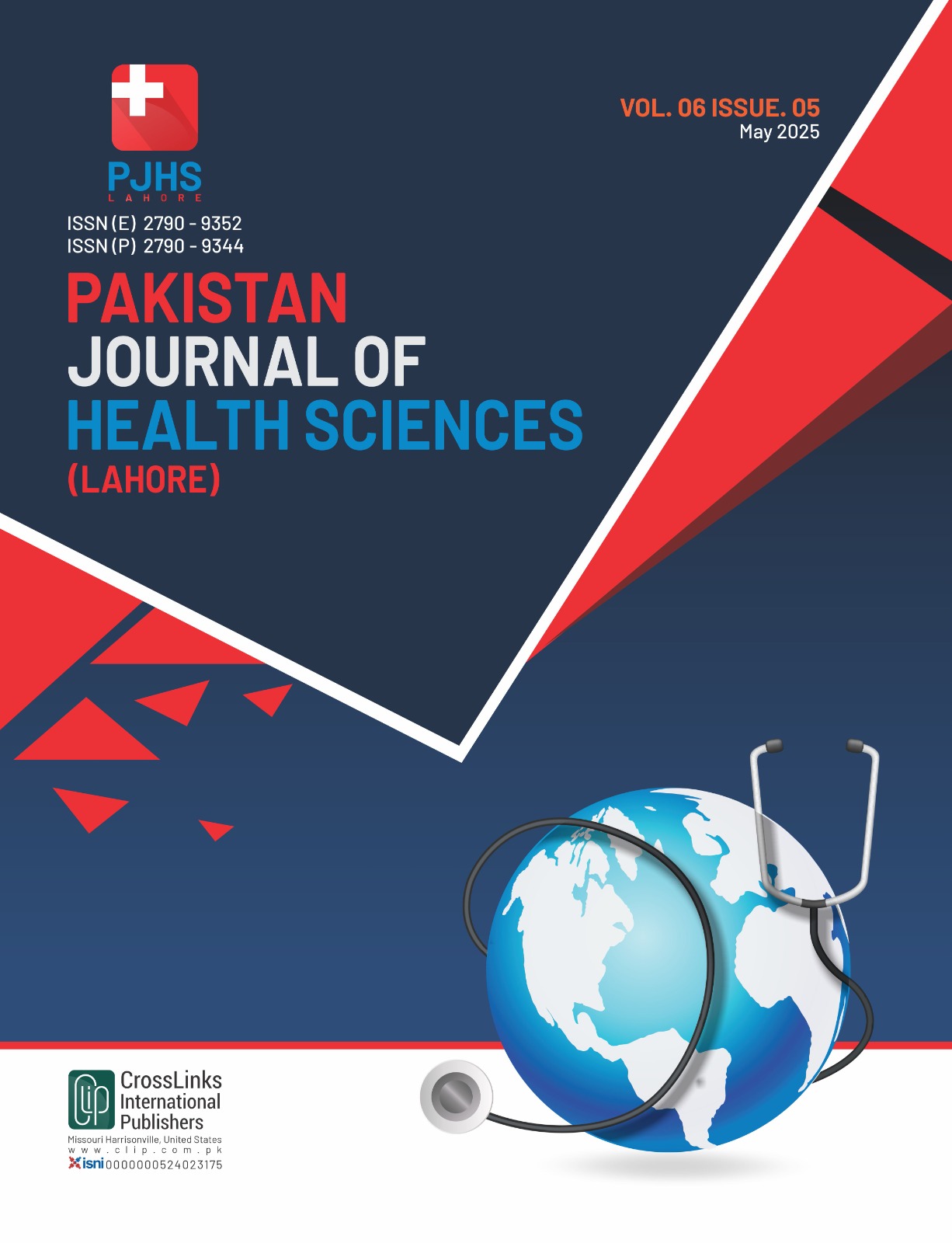Determination of Mean Blood Loss with Tranexamic Acid in Patients Undergoing Total Knee Arthroplasty
Mean Blood Loss with Tranexamic Acid Total Knee Arthroplasty Patients
DOI:
https://doi.org/10.54393/pjhs.v6i5.2844Abstract
Orthopedic surgeons routinely perform total knee arthroplasty (TKA). The use of antifibrinolytic therapy is one of the strategies to manage perioperative bleeding. TXA works by occupying the lysine-binding sites on plasminogen, thereby hindering its attachment to fibrin and ultimately halting the fibrinolysis process. Blood loss during gynaecological, cardiac, and orthopedic surgeries can be effectively managed with tranexamic acid. Objectives: To determine the average reduction in blood loss achieved with tranexamic acid in patients undergoing total knee arthroplasty. Methods: This interventional study was conducted over six months, from 25-08-2020 to 25-02-2021. A total of 60 patients from the OPD of the Orthopedic Department at Mayo Hospital, Lahore, were included in the study based on selected criteria. All participants signed informed consent forms. Demographic data were recorded, and TXA was administered after the surgery. All procedures were performed under general anesthesia. Results: The analysis showed that the average blood loss during surgery was 255.14 ml with the use of tranexamic acid. Excessive blood loss can have detrimental effects on a patient's health. Conclusions: It was concluded that tranexamic acid is effective in reducing bleeding during total knee replacement. Its use may also be more cost-effective compared to managing the consequences of significant blood loss.
References
Peng H, Ou A, Huang X, Wang C, Wang L, Yu T et al. Osteotomy around the knee: the surgical treatment of osteoarthritis. Orthopedic Surgery. 2021 Jul; 13(5): 1465-73. doi: 10.1111/os.13021. DOI: https://doi.org/10.1111/os.13021
Grayson CW and Decker RC. Total joint arthroplasty for persons with osteoarthritis. Physical Medicine and Rehabilitation. 2012 May; 4(5): S97-103. doi: 10.1016/j.pmrj.2012.02.018. DOI: https://doi.org/10.1016/j.pmrj.2012.02.018
Klein J. Repair or replacement--a joint perspective. Science. 2009 Jan; 323(5910): 47-8. doi: 10.1126/science.1166753. DOI: https://doi.org/10.1126/science.1166753
de l’Escalopier N, Anract P, Biau D. Surgical treatments for osteoarthritis. Annals of Physical and Rehabilitation Medicine. 2016 Jun; 59(3): 227-33. doi: 10.1016/j.rehab.2016.04.003. DOI: https://doi.org/10.1016/j.rehab.2016.04.003
Joelsson M, Olsson LE, Jakobsson E. Patients’ experience of pain and pain relief following hip replacement surgery. Journal of Clinical Nursing. 2010 Oct; 19(19‐20): 2832-8. doi: 10.1111/j.1365-2702.2010.03215.x. DOI: https://doi.org/10.1111/j.1365-2702.2010.03215.x
Banasiewicz T, Machała W, Wysocki MB, Lesiak M, Krych S, Lange M et al. Principles of minimize bleeding and the transfusion of blood and its components in operated patients-surgical aspects. Polski Przegląd Chirurgiczny. 2023; 95(5). doi: 10.5604/01.3001.0053.8966. DOI: https://doi.org/10.5604/01.3001.0053.8966
Frank SM, Chaturvedi S, Goel R, Resar LM. Approaches to bloodless surgery for oncology patients. Hematology/Oncology Clinics. 2019 Oct; 33(5): 857-71. doi: 10.1016/j.hoc.2019.05.009. DOI: https://doi.org/10.1016/j.hoc.2019.05.009
Klika AK, Small TJ, Saleh A, Szubski CR, Pillai AL, Barsoum WK. Primary total knee arthroplasty allogenic transfusion trends, length of stay, and complications: nationwide inpatient sample 2000–2009. The Journal of Arthroplasty. 2014 Nov; 29(11): 2070-7. doi: 10.1016/j.arth.2014.06.018. DOI: https://doi.org/10.1016/j.arth.2014.06.018
Noticewala MS, Nyce JD, Wang W, Geller JA, Macaulay W. Predicting need for allogeneic transfusion after total knee arthroplasty. The Journal of Arthroplasty. 2012 Jun; 27(6): 961-7. doi: 10.1016/j.arth.2011.10.008. DOI: https://doi.org/10.1016/j.arth.2011.10.008
Saleh A, Small T, Pillai AL, Schiltz NK, Klika AK, Barsoum WK. Allogenic blood transfusion following total hip arthroplasty: results from the nationwide inpatient sample, 2000 to 2009. The Journal of Bone and Joint Surgery. 2014 Sep; 96(18): e155. doi: 10.2106/JBJS.M.00825. DOI: https://doi.org/10.2106/JBJS.M.00825
Kim C, Park SS, Davey JR. Tranexamic acid for the prevention and management of orthopedic surgical hemorrhage: current evidence. Journal of Blood Medicine. 2015 Aug: 239-44. doi: 10.2147/JBM.S61915. DOI: https://doi.org/10.2147/JBM.S61915
Hunt BJ. The current place of tranexamic acid in the management of bleeding. Anesthesia. 2015 Jan; 70: 50-e18. doi: 10.1111/anae.12910. DOI: https://doi.org/10.1111/anae.12910
Charoencholvanich K, Siriwattanasakul P. Tranexamic acid reduces blood loss and blood transfusion after TKA: a prospective randomized controlled trial. Clinical Orthopedics and Related Research. 2011 Oct; 469: 2874-80. doi: 10.1007/s11999-011-1874-2. DOI: https://doi.org/10.1007/s11999-011-1874-2
Roy SP, Tanki UF, Dutta A, Jain SK, Nagi ON. Efficacy of intra-articular tranexamic acid in blood loss reduction following primary unilateral total knee arthroplasty. Knee Surgery, Sports Traumatology, Arthroscopy. 2012 Dec; 20: 2494-501. doi: 10.1007/s00167-012-1942-5. DOI: https://doi.org/10.1007/s00167-012-1942-5
Zhang Y, Fu X, Liu WX, Li YM, Ma XL, Li ZJ. Safety and efficacy of intra-articular injection of tranexamic acid in total knee arthroplasty. Orthopedics. 2014 Sep; 37(9): e775-82. doi: 10.3928/01477447-20140825-53. DOI: https://doi.org/10.3928/01477447-20140825-53
van den Boogaard WM, Komninos DS, Vermeij WP. Chemotherapy side-effects: not all DNA damage is equal. Cancers. 2022 Jan; 14(3): 627. doi: 10.3390/cancers14030627. DOI: https://doi.org/10.3390/cancers14030627
Bidolegui F, Arce G, Lugones A, Pereira S, Vindver G. Tranexamic acid reduces blood loss and transfusion in patients undergoing total knee arthroplasty without tourniquet: a prospective randomized controlled trial. The Open Orthopedics Journal. 2014 Jul; 8:250. doi: 10.2174/1874325001408010250. DOI: https://doi.org/10.2174/1874325001408010250
Yen SH, Lin PC, Chen B, Huang CC, Wang JW. Topical tranexamic acid reduces blood loss in minimally invasive total knee arthroplasty receiving rivaroxaban. BioMed Research International. 2017; 2017(1): 9105645. doi: 10.1155/2017/9105645. DOI: https://doi.org/10.1155/2017/9105645
Lane NE and Wallace DJ. All about Osteoarthritis: The definitive resource for arthritis patients and their families. Oxford University Press. 2002 Mar. doi: 10.1093/oso/9780195138733.001.0001. DOI: https://doi.org/10.1093/oso/9780195138733.001.0001
Surannavar J. The Effect of Tranexamic Acid on Haemoglobin Level During Surgeries Around Hip (Master's thesis, Rajiv Gandhi University of Health Sciences (India)). 2014.
Khan N, Troelsen A, Husted H. Prevention of post-operative anemia in hip and knee arthroplasty--a systematic review. Danish Medical Journal. 2015 Dec; 62(12): A5170.
Pedneault C, St George S, Masri BA. Challenges to implementing total joint replacement programs in developing countries. Orthopedic Clinics. 2020 Apr; 51(2): 131-9. doi: 10.1016/j.ocl.2019.11.001. DOI: https://doi.org/10.1016/j.ocl.2019.11.001
Poeran J, Rasul R, Suzuki S, Danninger T, Mazumdar M, Opperer M et al. Tranexamic acid use and postoperative outcomes in patients undergoing total hip or knee arthroplasty in the United States: retrospective analysis of effectiveness and safety. British Medical Journal. 2014 Aug; 349. doi: 10.1136/bmj.g4829. DOI: https://doi.org/10.1136/bmj.g4829
Fillingham YA, Ramkumar DB, Jevsevar DS, Yates AJ, Shores P, Mullen K et al. The safety of tranexamic acid in total joint arthroplasty: a direct meta-analysis. The Journal of Arthroplasty. 2018 Oct; 33(10): 3070-82. doi: 10.1016/j.arth.2018.03.031. DOI: https://doi.org/10.1016/j.arth.2018.03.031
Downloads
Published
How to Cite
Issue
Section
License
Copyright (c) 2025 Pakistan Journal of Health Sciences

This work is licensed under a Creative Commons Attribution 4.0 International License.
This is an open-access journal and all the published articles / items are distributed under the terms of the Creative Commons Attribution License, which permits unrestricted use, distribution, and reproduction in any medium, provided the original author and source are credited. For comments













